
Yellow Mountain Scenic Area announced that from December 1, 2024, Xihai Great Valley and Heavenly Capital Peak will be closed for winter maintenance. At the same time, West Gate will also be closed. The date of the resumption will be announced separately. Lotus Peak keeps closed.

Foreign tourists visiting Huangshan Mountain, Hongcun Ancient Village and other 22 attractions in 2024 will be eligible for a preferential 50% discount on entrance fees.
Huangshan City, established as the scenic support area for Huangshan Mountain (Yellow Mountain), has become a tourist city that includes Huangshan Mountain Scenic Area and many other attractions.
Top Things to Do
 Huangshan Mountain
Huangshan Mountain Tunxi Old Street
Tunxi Old Street Xidi and Hongcun Ancient Villages
Xidi and Hongcun Ancient Villages Most tourists in the city visit Huangshan Mountain Scenic Area which is well-known for its four wonders of spectacular peaks, odd-shaped pines, hot springs and seas of cloud. It is one of the famous mountains symbolizing the Chinese nation. Huangshan Mountain abounds in miraculous scenic spots including peaks, rocks, pines, clouds, waterfalls, springs and historical sites.
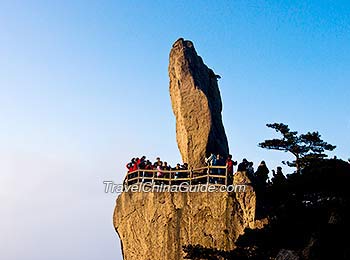 | | Flying Over Stone on Huangshan Mountain | | 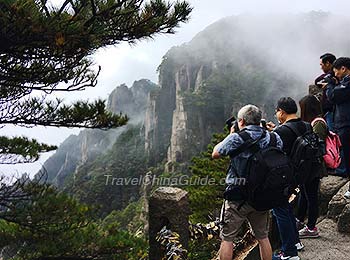 | | West Sea Valley in Huangshan Mountain | |
It takes you over one hour from the City Bus Station to Huangshan Mountain Scenic Area Bus Station by bus. It will save some time if you charter a Santana (about RMB 100).
Tunxi Old Street is a well-preserved mercantile street with the architectural styles of the Song (960-1279), Ming (1368-1644) and Qing (1644-1911) dynasties located in the center of Tunxi old city. The group of architectures alongside the street followed both the Song Dynasty style and the traditional Hui (Anhui Province) folk residences style, presenting the charm of ancient towns in the southern lower reaches of the Yangtze River. More than ten famous old shops are situated here, including Tongrende, opened about 120 years ago in the Qing Dynasty, is the most remarkable one. Many other stores here deal primarily in folk artworks such as traditional Chinese paintings of the Hui (Anhui Province) sect, miniature gardens, root-carvings, prints and inscriptions. Today Tunxi Old Street, the folk art corridor in China is popular with movie and television companies since its scene of dense traditional commercial atmosphere, some experts believe the ancient street resembles the famous Song Dynasty painting, 'The Upper River during the Qing Ming Festival'.
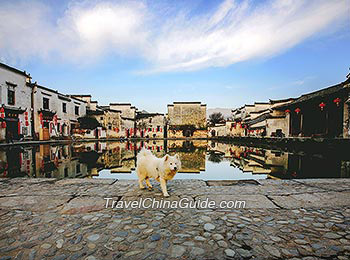 | | Hongcun Village | | 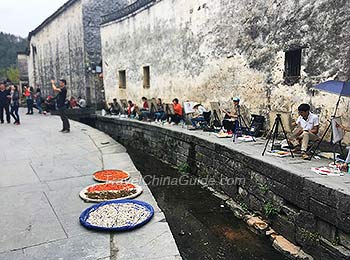 | | Xidi Village | |
Shexian County, situated at the south foot of Huangshan Mountain, is a famous historical and cultural place. The county abounds in Ancient Residential Houses, memorial archways and Ancestral Temples. It is famed as Town of Arch. Most villages here show typical southern Chinese scenery featured by little bridges, murmuring streams and classical architectures. Huizhou Ancient City
Huizhou Ancient City Qiankou Residence
Qiankou Residence
 Chengkan Village
Chengkan Village Tangmo Ancient Village
Tangmo Ancient Village Bao's Family Garden
Bao's Family Garden 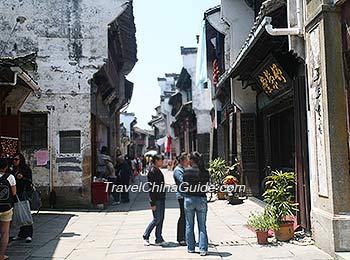 | | Tunxi Old Street | | 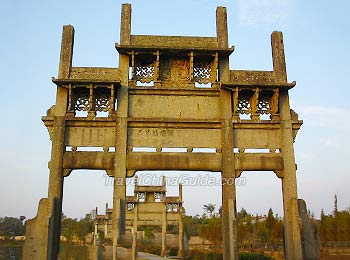 | | Tangyue Memorial Archway | |
The archway has long been a symbol of China. In Chinese feudal society, the government built archways for calling people to receive recognition for merit, acts of faith or filial piety, rewards for rendering service to the country. As many celebrities in Chinese history came from this city, archways were constructed in many quarters of in this area. Many years later, over 100 well-preserved archways remain. Tangyue Memorial Archways are the most representative, including three from the Ming Dynasty and four from the Qing Dynasty. Each archway has a moving story, worthy of a visit.
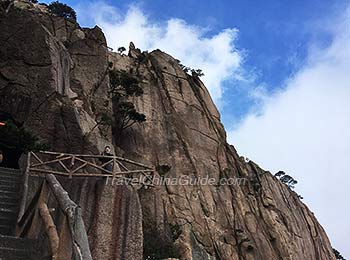 |
| Huangshan Mountain |
Xidi, a cymbiform village, and Hongcun, a cattle-like village, were ancient settlements in southern Anhui Province listed as world cultural heritage sites by UNESCO in 2000. Xidi and Hongcun Ancient Villages retain much of the appearance of the last century. The style of the street, architecture, and the development of a complete water supply are notable. Elegant residences from the Ming and Qing Dynasties, the soul of Chinese traditional residences, created a logical, spicy living environment. The water system in Hongcun especially demonstrates advanced thinking.
The largest group of stone caves in China, Flower Mountain and Enigma Caves, is in the mountains along the Xin'an River, in east Tunxi. The 36 stone caves left modern people many enigmas. Within the specially designed and logically structured caves you can feel the wisdom of the ancient people. How or why they were constructed is a mystery.
Mount Jiuhua is the first mountain in southeast China to become famous for its scenery. Mount Jiuhua, one of the four famous mountains of Chinese Buddhism, is a charming pearl in Chinese cultural heritage. Mount Jiuhua is host to temples and wreathing incense smoke, blending natural beauty with a Buddhist atmosphere.
Other attractions include Mt. Qiyun, Xin'an River, Guniu Mountain Nature Reserve and Mukeng Bamboo Forest are all worthwhile to visit.
- Last updated on Nov. 27, 2024 by Gabby Li -







